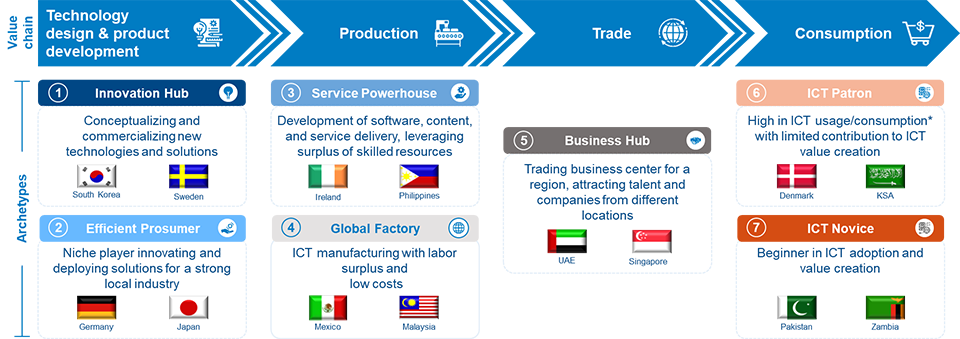Digital Economy Policy

Accelerating the transition to a digital economy will boost industrial growth and productivity, improve societal well-being and benefit consumers via cost and time savings. Successful digital economies require a whole range of infrastructure and capabilities, but countries often have scarce resources and finite funds. Choosing and prioritizing focus areas is therefore key.
The report begins with the recognition and definition of country archetypes, designed to act as a reference model that countries can adapt based on their current situation. The identified seven digital economy archetypes are as follows: Innovation Hubs, Efficient Prosumers, Service Powerhouses, Global Factories, Business Hubs, ICT Patrons and ICT Novices. Each differ in their presence or dominance in the ICT value-chain step.
Nations need to develop digital value creation paths that align with their most suitable archetypes, leveraging their inherent strengths, but anchored by their economic and technological realities.
Identification of a country’s archetype helps tailor the recommendations for digital economy policies to ensure they are best aligned with its needs. Huawei and ADL develop a tool to identify 200+ countries/regions’ archetypes as part of this study.

Digital economy archetypes with country examples
The importance of digital economy policies vary fundamentally between archetypes. Different combinations of policies should be considered for different archetypes. Policy makers need to formulate policies, laws and regulations across four interrelated policy dimensions – technology, capabilities, ecosystem and industry – as these are the driving forces underpinning national digital transformation.
This report outlines a strategic approach for developing digital economies for all countries based on their potential archetypes. It also recommends an overarching policy framework tailored towards each. It additionally provides examples of how countries have successfully transitioned across archetypes. In particular, it provides guidance for developing a digital strategy tailored to the country that reflects a whole-of-government approach to policy making in the digital age. A repository of best-practice digital economy policies from around the world based on proven efficacy, accompanies the research recommendations.
